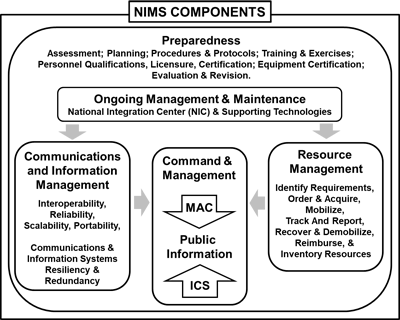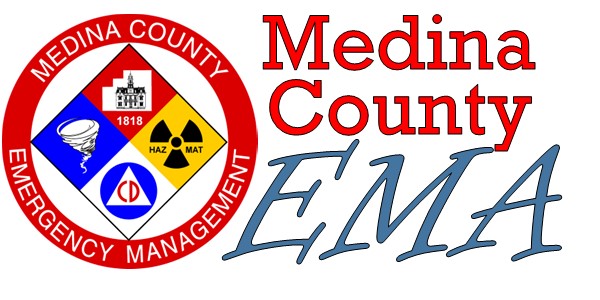
The National Incident Management System (NIMS) is a standardized approach to incident management developed by the United States Department of Homeland Security. It was established in 2004 to provide a common framework for coordinating and collaborating across different agencies and organizations during emergencies and planned events.
The purpose of NIMS is to enhance the ability of the whole community to prevent, protect against, mitigate, respond to, and recover from incidents, regardless of their cause, size, location, or complexity. NIMS aims to improve interoperability, communication, resource management, and situational awareness among all stakeholders.
Components of NIMS
- Resource Management: The process of identifying, typing, ordering, tracking, and allocating resources before, during, and after an incident.
- Command and Coordination: The systems and structures that enable effective leadership and direction of incident operations.
- Communications and Information Management: The systems and protocols that ensure timely, accurate, accessible, and consistent information exchange among all partners.
- Joint Information System: The mechanism that integrates public information activities across jurisdictions and organizations.
- Training: The activities that prepare personnel for their roles and responsibilities in NIMS.
- Exercises: The activities that test and evaluate the capabilities and performance of NIMS components.
- Public Information: The processes and methods for communicating with the public and the media during an incident.
- NIMS Management and Maintenance: The processes and procedures for updating and revising NIMS based on lessons learned and best practices.
Benefits of NIMS
- It provides a common language and framework for all partners to work together effectively.
- It enhances the efficiency and effectiveness of resource allocation and utilization.
- It improves the coordination and collaboration among different levels of government, sectors, disciplines, and jurisdictions.
- It fosters a culture of preparedness and continuous improvement among all stakeholders.
- It supports the development and maintenance of national preparedness capabilities.
NIMS Audience
NIMS training is required for all personnel involved in emergency management and incident response. This includes Federal, State, tribal, local, private sector and nongovernmental organizations. NIMS training is also encouraged for government executives, private-sector and NGO leaders, and other individuals with emergency management responsibilities.
Elected and appointed officials and policy makers, who are responsible for jurisdictional policy decisions, must also have a clear understanding of NIMS to better serve their constituency.
NIMS Training
The NIMS Training Program defines the national NIMS training program as it relates to the NIMS components of Preparedness, Communications and Information Management, Resource Management and Command and Management. It specifies NIC and stakeholder responsibilities and activities for developing, maintaining and sustaining NIMS training. The NIMS Training Program outlines responsibilities and activities that are consistent with the National Training Program, as mandated by the Post-Katrina Emergency Management Reform Act of 2006. This program integrates with FEMA training offered through the Emergency Management Institute (EMI) and United States Fire Administration (USFA).
Everyone involved in emergency management (to include emergency operation center personnel in support of the field), regardless of discipline or level of government, should take the NIMS baseline curriculum courses (Independent Study-700 and ICS-100). Incident command occurs in the field; therefore, the NIC recommends that only individuals with a command and general staff role take advanced ICS courses.
Fulfilling the training associated with this plan helps emergency management organizations, departments and agencies to develop preparedness capabilities for effective and efficient incident management. As a result, trained emergency responders are available as mutual aid to support incident management in other jurisdictions, if requested. The NIMS Training Program should sustain a personnel qualification system that is coordinated, maintained and meets the needs of the emergency management community.
Elected and appointed officials should have a clear understanding of their roles and responsibilities for successful emergency management and incident response. To that end, it is vital that elected and appointed officials understand and receive NIMS training.
| Incident Positions | IS-100 | IS-700 | IS-800 | IS-200 | G191 | E/L/G 300 | E/L/G 400 | Position-specific PTB training |
|---|---|---|---|---|---|---|---|---|
| All incident personnel supporting ICS | X | X | ||||||
| ICS personnel with leadership responsibilities | X | X | X | X | ||||
| ICS personnel with leadership responsibilities preparing for additional responsibility | X | X | X | X | X | X | ||
| ICS personnel in leadership/supervisory roles | X | X | X | X | X | X | X | |
| IMT unit, strike team, resource team, or task force leaders preparing for complex incidents | X | X | X | X | X | X | X | |
| IMT command, section, branch, division, or group leaders preparing for complex incidents | X | X | X | X | X | X | X | X |
